Andouille Sausage Links, Cajun Style
March 21, 2012 | Updated September 04, 2022
As an Amazon Associate I earn from qualifying purchases.
Along with the hot dog, Louisiana andouille sausages are quintessentially American. Here’s a traditional recipe for making them at home.
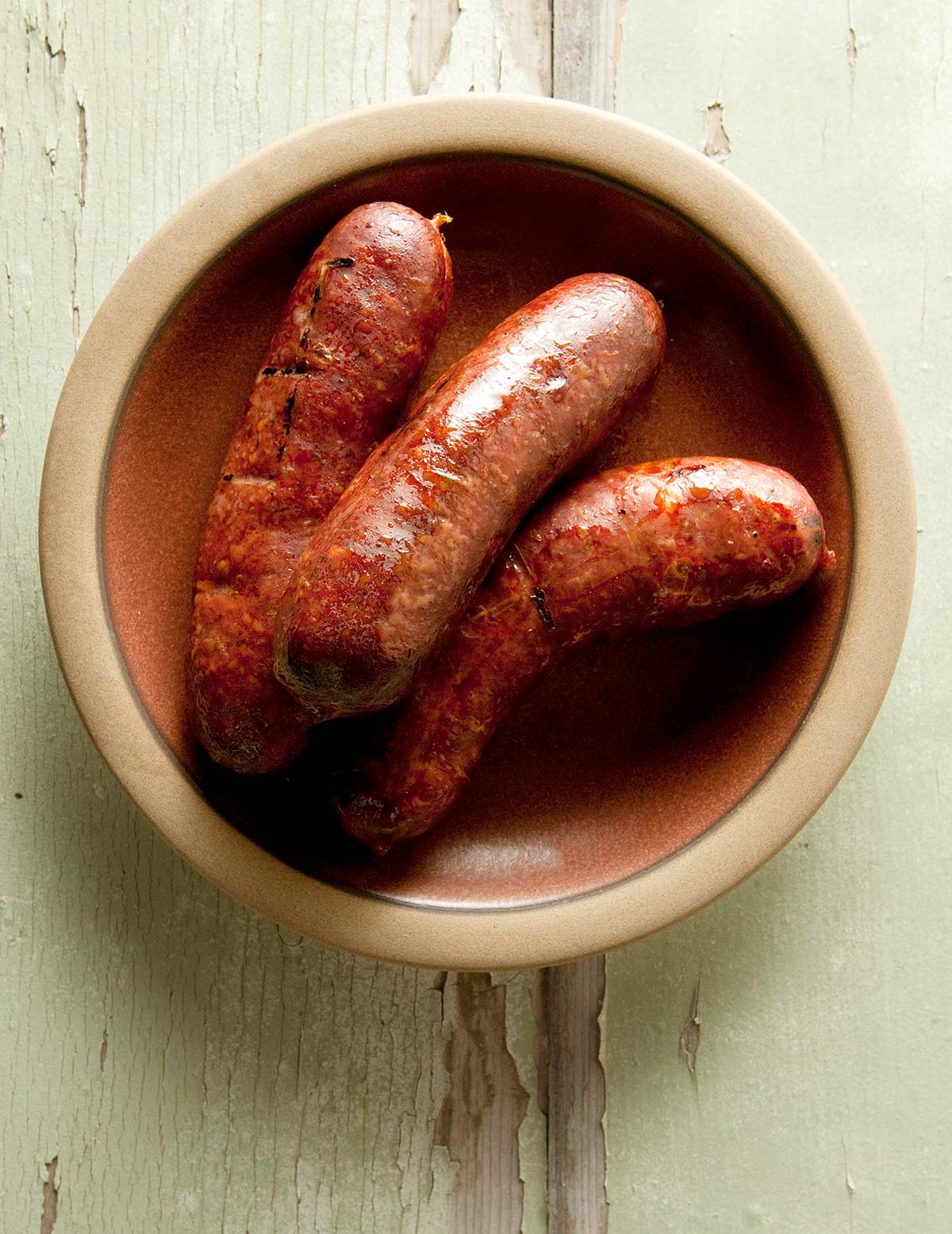
And like the hot dog, andouille sausage too owes at least part of its origins to Germans, even though with a French name it sounds counterintuitive. So far as I can tell, Louisiana-style andouille sausages are a product of early German immigration — and when I mean early I mean the 1750s, when Louisiana was part of France.
France still has versions of andouille, but the American variety has been evolving independently for centuries, and no longer resembles its ancestors.
What Makes Andouille Unique?
Andouille sausage is a Cajun creation, most at home in southern Louisiana, but it also appears a lot in New Orleans Creole cooking, too. It is almost always smoked and heavily seasoned. Typically andouille is seasoned with garlic, cayenne or other hot chiles, black pepper and usually thyme. Sometimes cooked onions appear in the mix.
Remember, there are as many versions as there are cooks, and Louisianans guard their recipes closely. (Note: If you are looking for that other quintessential Cajun sausage, boudin, my recipe for that is here.)
Andouille is chunky, too. Some cooks hand mince everything and stuff that into casings, which is cool, but very labor intensive. I prefer to hand mince about a quarter of the meat and fat, then grind the rest through a coarse die of about 7 or 8 mm.
The other unique thing about andouille sausage is how it is smoked. In Cajun country, andouille is smoked over spent sugar cane stalks after they’ve been pressed for sugar, hackberry wood or pecan — or a combination of the three. For home cooks, pecan is the easiest to obtain.
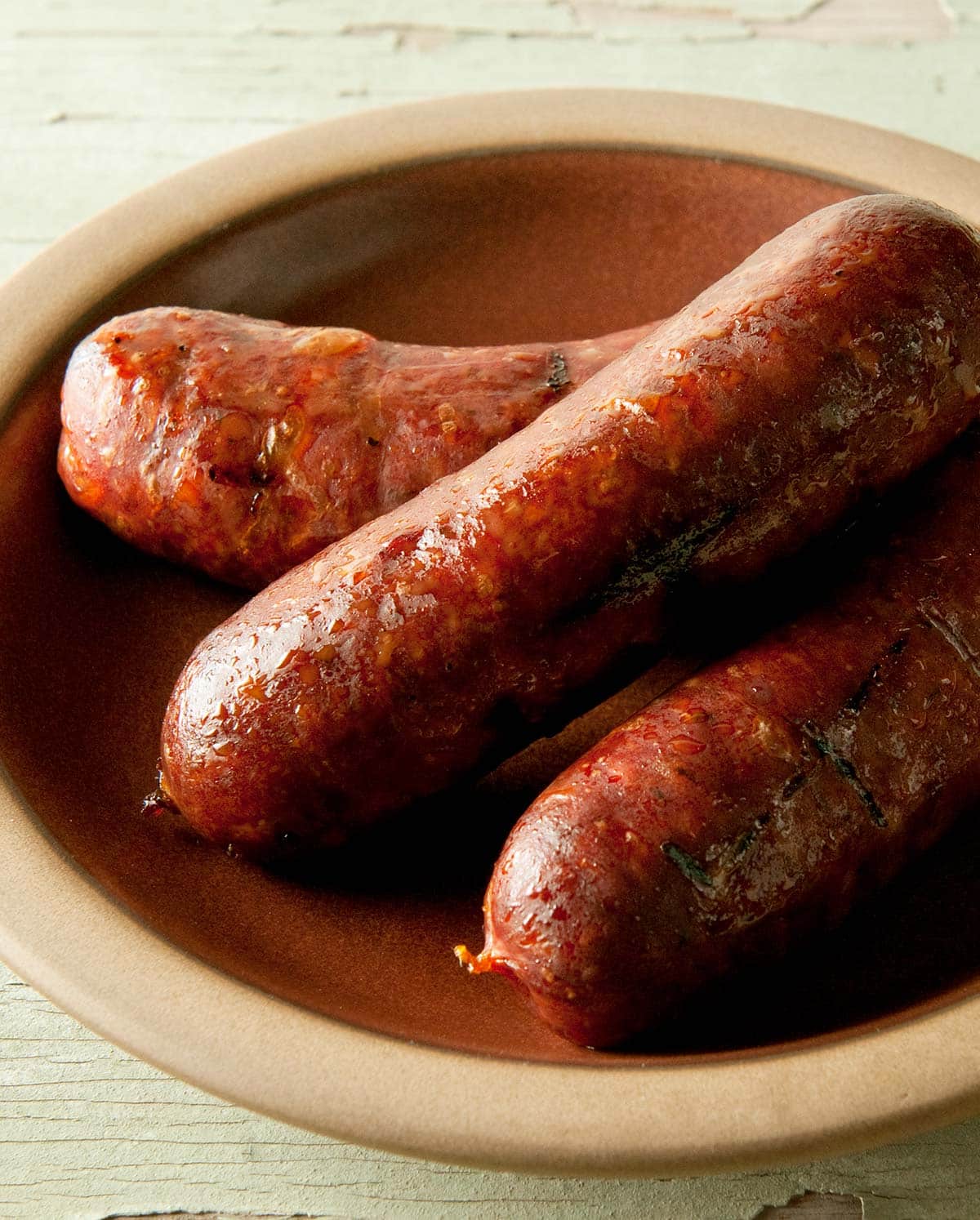
What Meat is in Andouille?
Normally andouille is a 100 percent pork sausage, but my homemade version is a mix of venison and pork. Why? It’s what I had lying around in the freezer. Frankly, andouille is so heavily spiced and smoked you can make it with whatever meat you have on hand.
I’ve seen andouille made with rabbit and gator, venison, beef, you name it. Cajuns are resourceful and thrifty. But pork fat is key: I’ve never seen or heard of an andouille sausage that didn’t have pork fat in it, regardless of the other meats.
How to Use Andouille Sausage
There is no reason you can’t just eat an andouille sausage: A link served on a bun with green peppers, minced celery, onions and Creole mustard would be damn good — Cajun hot dog! But it is typically tossed into other dishes, like gumbo or jambalaya.
Andouille shows up as an accent in lots of dishes, from the aforementioned gumbo and jambalaya to courtbullion, etouffée, shrimp and grits and sometimes sauce piquante.
Once smoked, andouille sausage lasts in the fridge a week or so, and it freezes very well. Remember these will be cooked sausages, so once you decide to use your andouille you’ll just be reheating them, not cooking them.
For hunters: If you are starting with frozen wild game, you can thaw it, make these sausages, smoke the links and then refreeze them. So long as you cook them to an internal temperature of at least 150°F, the texture of the sausages will not suffer too much.
Cajun Andouille Sausage
Ingredients
- 3 1/2 pounds venison, pork, beef or other meat
- 1 1/2 pounds pork belly or fatty shoulder
- 33 grams kosher salt, about 3 tablespoons
- 4 grams Instacure No. 1, about a teaspoon
- 3 tablespoons minced fresh garlic
- 2 teaspoons cayenne
- 2 tablespoons sweet paprika
- 2 teaspoons dried thyme
- 1/2 cup ice water or beer (put in fridge to keep it cold)
- Hog casings
Instructions
- Take about 10 to 15 feet of casings (typically three lengths) and submerge them in warm water.
- Cut the meat and fat into chunks and toss with the salt, Instacure, garlic, cayenne, paprika and thyme. You need the Instacure No. 1 as a safety measure when you smoke the links; if you don't plan on smoking them, you need not use this. Put everything in a container and freeze for 30 minutes to 1 hour, or until the mixture is 35°F or colder. You can also put the mix in the fridge overnight; this will help the bind.
- Grind everything through the coarse die, 7 or 8 mm. Andouille is most typically a country-style, coarse sausage. If you want, you can even hand-mince the meat yourself. If you want to do this, hand mince 1/4 of the meat and fat mixture to get a more interesting texture for your sausage.
- Make sure the mixture is very cold, about 30°F; you will probably need to freeze it again for a while. When it's cold enough, take it out and add the chilled water or beer to the bowl and mix on the lowest setting for 90 seconds to 2 minutes, or with your very clean hands for 2 minutes. The look of the meat will change as it binds to itself, and will look more like thick batter than ground meat and fat.
- If you are making patties, you're done. Store each patty between pieces of wax paper and then wrap tightly in plastic wrap, then foil, before freezing. If you are making links, load up a sausage stuffer with the meat and fat. Rinse the casings by running warm water through them: You want to flush some salt and check for any holes in the casings. Thread an entire casing onto the stuffer and fill it slowly. Coil the filled casing as you go. Fill all the casings before making individual links.
- To make individual links, tie off one end of a casing. Compress the sausage inside it to fill that end link. Pinch off a link and flip it away from you several times to tighten it. Move down the coil and pinch down another link. This time, flip the link back toward you to tighten it. (Here's a quick video on making the links) Repeat this process down the coil until you get to the end. Tie off the end link. Repeat with all the other casings.
- Hang your sausages to dry for an hour or more. Hang for 1 to 2 hours at room temperature, or up to overnight where your temperatures are below 45°F. I use a standard clothes drying rack to hang my links. When the sausages are hanging, use a large needle to pierce any spots on the links where there is air trapped underneath. Sterilize the needle in the flames of a gas burner or with a lighter until it glows. You need to pierce any trapped air or your links could burst when you cook them.
- Once the sausages have hung, smoke them over pecan wood for 3 to 4 hours. If you hot-smoke your links, pull them when they reach an internal temperature of 155°F. If your links don't get to that temperature in time, you can either smoke them longer, or you can finish the cooking in an oven set at 200°F. Once they're fully cooked, let them cool before freezing.
Nutrition
Nutrition information is automatically calculated, so should only be used as an approximation.

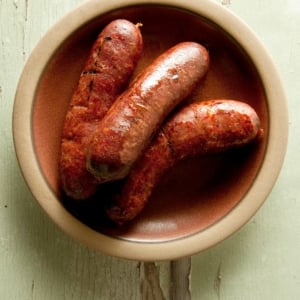
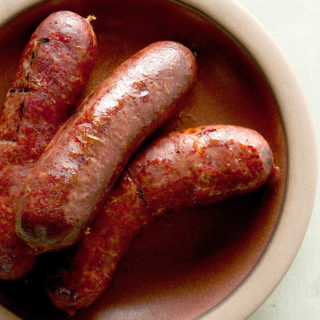


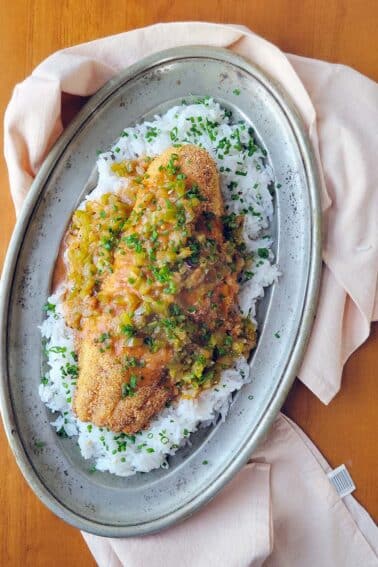
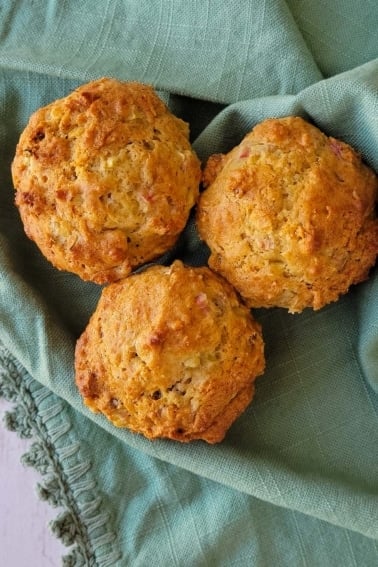
I make this recipe every year and today I’m repeating that routine.
I’d swear that it used to have mustard, cloves, and allspice in it.
Has the recipe changed or am I just getting old?
Dave: I did remove the cloves and allspice, but it never had mustard. If you want to add those two spices, it’s just a 1/2 teaspoon of each.
I ad-libbed a half teaspoon of each so I got that part right. I hope the tablespoon of mustard doesn’t hurt but hard to see how that’s bad.
Out of curiosity, what made you decide to skip the allspice and clove?
PS. I’d like to buy an individually autographed Buck Buck Moose as a gift for a friend.
If you’re still able to do that, please email me at the address on my post
Dave: I got a lot of comments from Louisianans saying that the allspice and clove weren’t very common. And no, I can’t personalize books that I mail — they are in Michigan and I am in California. I do sell books that are signed, however.
I unerstand re: personalized.
I will buy a signed book from whatever source pays you the most. If that’s direct, please email me. If that’s Amazon or some other on line, just LMK.
This is a gift for a buddy. My copy was personally signed by you at Filson’s in SF!
I am making a large batch which I used the scale tool when printing the recipe so will be starting with 30 lb or pork and 13 lbs of pork belly. My understanding is for the curing salt, it does not measure linear as most other ingredients do. Meaning the amount of curing salt is not the same proportionally when I scale it up. How do I determine how much curing salt to use for this size batch and are there any other ingredients that would not scale proporionally that I should be aware of?
Bob: Curing salt should always be close to 0.25% of the weight of the meat and fat, so go with that.
Tried this recipe today and absolutely love it! Thanks for sharing ??
At what temperature do you define hit smoking?
Donna: Any temperature over 85F is considered hot smoking.
Hi there, I was curious if it’s necessary to smoke the sausage at all? Is there anyway I could do the “smoking” in the oven if it is? Thanks in advance
Anna: No, it’s not necessary, but all andouille is smoked. It makes a fine sausage without smoking, but traditionally you would smoke it.
Hi. Could you cold smoke these, refrigerate and then fry up when eating?
Sarah: Absolutely.
If hot smoking and cooking fully do you still need the Instacure No. 1? I’m looking to reduce sodium in my diet
Steve: Yes, you do. Just drop the amount of regular salt a little then, if you want.
I’ve made these and they are great. My casings get tough sometimes and I wish I knew why also we have a local shop that makes a cabbage sausage(rytek kutas has a recipe in his book for one) that they add gnocchi to, do u have a recipe? Great site!!
Great recipe! There’s nothing better than Louisiana style andouille sausage.
Hi there….I stumbled across your site, I was searching for andouille recipes. WOZA your recipe is great. I actually made chicken andouille using your recipe. Just to make meatballs, not going to smoke them. They turned out amazingly! Thank you for the great resource.
Hi Hank,
What size/type of casings should I use for these?
Eddie: Hog casings. Any size you can find.
Delicious!
I combined the ingredients in a bowl to make sausage patties for breakfast and to add to omelettes. I only had one lb of ground fatty pork, I didn’t add the liquid smoke and I used red wine that had been in the fridge for a while.
I will definitely make again (in casings) with a combination of meats and I’ll fire up the smoker.
Next time I’m on Oz, I’ll definitely try with kangaroo.
Nice job!
I’m a bit OCD, can you clarify which to use between the weights or measurements, they are quite a bit different.
Gary: For me, always metric.
Use weight for consistency.
Hank,
Great recipe! I am going to have to use collagen casings as I cannot get natural ones where I am. Is there anything different that I need to do?
Made 8.5 lbs using pork butt and adjusted ingredients accordingly. Smoked 3 hours with hickory. My new favorite sausage recipe. The balance of flavors is perfect. Thanks Hank.
Made this last night. Not only did they look amazing on the grill but the balance of seasoning and heat is spot on. My favorite sausage I have ever made. Thanks for posting!
I live in Pakistan, but miss andouille from my Tulane days, so looking to make this and then use it for jambalaya and gumbo. Would really appreciate it if you could help with a couple of questions.
1. I will be using lamb. Should I just use fatty meat? Or should I also use the nice chucks of fat that come from the fat tail lamb? Alternately, do you think it would be better if I used a combination of beef and lamb?
2. I don’t have a smoker. Do you think a combination of a bit of liquid smoke and oven-cooking would work? I would add a teaspoon of hickory liquid smoke to the mix and then cook it at 200F for say, 3 hours?
Thank you in advance 🙂
Arif: Yes, fatty meat. All lamb is OK. If you use liquid smoke you don’t need to pre-cook them. Just add it to the sausage mix and then grill as you would a fresh sausage. Ideally, you would skip the liquid smoke and cook your sausage outside very slowly over a smoky fire.
I only have a very basic barbie, so hot smoking on it is a bit problematic. I still haven’t got the hang of it. However, i bought a very nice cold smoke generator (haven’t used it though, yet ?). Will it do for this recipe?
I have some liquid smoke as well.
Aleksandra: Yes, you can cold smoke the sausages.
Just finished smoking my first batch using trim from pork ribs/shoulders. Holy cow is that stuff good! Can’t wait to do some gumbo and shrimp boils!
This recipe has my friends and neighbors thinking I have Cajun blood in me.
Absolutely amazing. Easy to make, easy to modify (if you choose…make it as shown first), and WAY too easy to eat!
Two things I recommend when making this recipe:
1. Double the cayenne pepper. The little extra kick is awesome.
2. Use Shiner Bock for the beer. When done measuring for the recipe, consume the remainder directly from the bottle.
I made these for the 3rd time and have used lamb, pork and black bear. Black bear was my favourite.
I have had bear before and thought it was only good for rendering but that sounds incredible. Did you adjust the spice mix?
I used to be able to get kosher andouille sausage but no one makes it anymore. Going to try your recipe. Since I won’t use pork, would chicken or turkey be an ok substitute? Can I used already ground poultry or grind it myself? Also for the fat can I use rendered chicken fat or should I just use the fat from a whole chicken. Can’t wait to try this.
Toby: I’d use beef. You need fat in sausage, and beef or lamb will get you there, where poultry will not. And you cannot use rendered fat in this sausage, and I would not use unrendered poultry fat, either.
So I should use fatty beef or lamb and not add chunks of fat? I just ordered the meat grinder attachment but can’t find kosher casings to buy in a small quantity but this isn’t an issue
Toby: I would use very fatty beef, but not chunks of beef fat because using fatty cuts, or fat trimmed off a steak, will be less waxy than fat from, say, the kidney, which is where you get tallow. Kosher casings? Easy. Buy the collagen ones, or sheep casings. They’re not made from pork. I use these: https://www.sausagemaker.com/22-24mm-natural-sheep-casings-p/17-1114.htm
Fantastic flavor and easy recipe to follow! I just finished smoking a small batch (5 lbs) using elk. Great flavor. I ate a couple while waiting for the full batch to cool and wish I would have slowed down long enough to enjoy them with some grainy mustard! One question — when smoking do you have a tip for keeping the casing as soft as possible? I was multitasking while working from home and ended up cooking them to around 165F internal — so the longer cook time may have affected the finished product. And I started at 180F but bumped to 225F cooking temp — any idea if a lower, slower smoke process yields a more tender casing? I’ll do some experimenting but would welcome any input.
Not a huge sausage expert yet, but your question seems to me more related to cooking meat in general. I would “guess” that low and slow will not produce as soft a casing as possible . With meat you generally have two categories, and with encased meat, you may have four. Generally, with meat, it’s about searing (cooking the outside very quickly at very high heat to seal in the juices) then evenly and slowly heating the inside, which seems to play right into sausage (meat wrapped in meat). The other method is smoking; cooking at a low temperature while introducing savory wood smoke the entire time. This is what I think you are talking about. One advantage to cooking at a low temperature for a long time is that the collagen breaks down, and turns from inedible material (gristle/intestine), to delicious melted meat fat. I do think, with little experience, that it is certainly possible that a combination, beginning with a HOT sear, then low and slow might produce exactly the tender catextures you are looking for. Also, don’t forget, a finer grind for your sausage is always an option; it might give you enough to sear the outside while giving you delicious smoked pork on the inside.